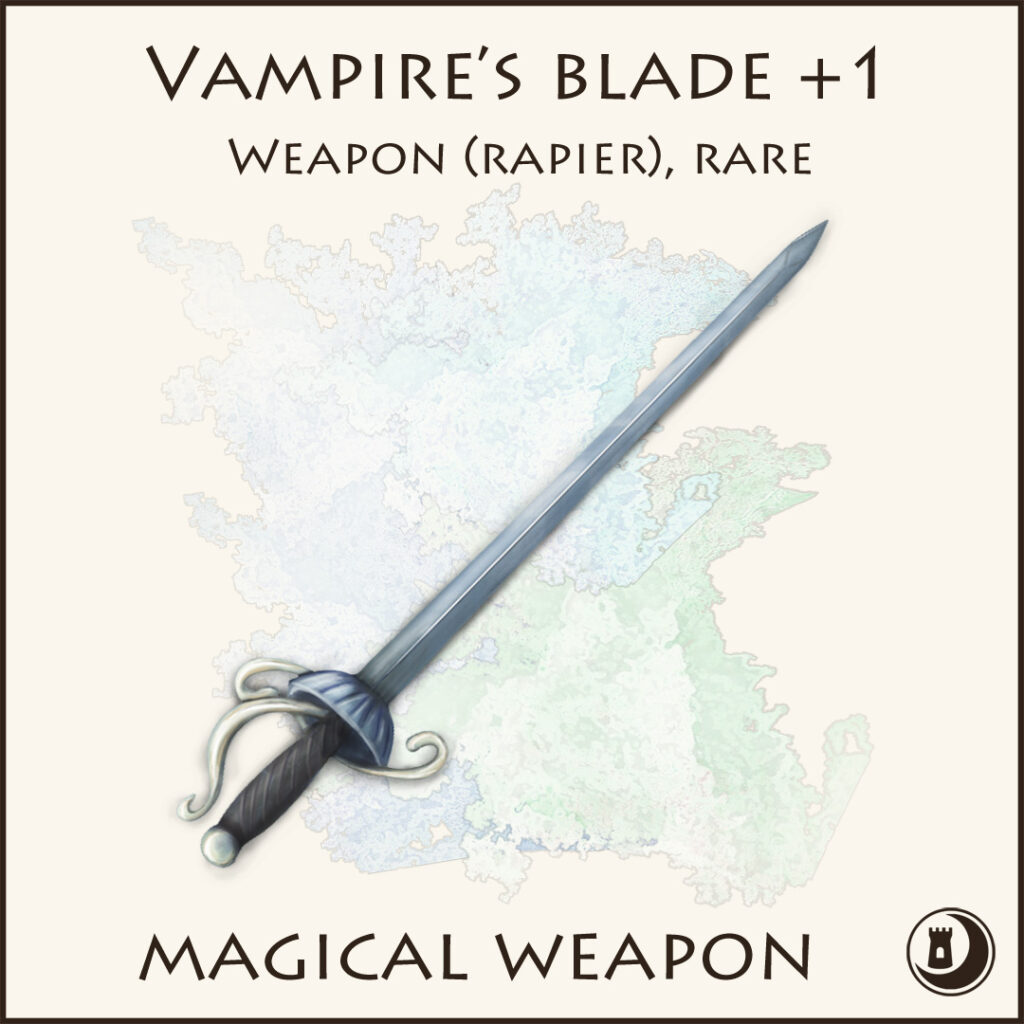
Vampire’s Blade
Weapon (any blade), uncommon (+1), rare (+2), or very rare (+3)
A Vampire’s Blade is a weapon that has belonged to a vampire for centuries and absorbed some of its owner’s undead abilities – and weaknesses. It is typically a rapier or a longsword, but it can be any bladed weapon that deals slashing damage.
You have a bonus to attack and damage rolls made with this magic weapon. The bonus is determined by the weapon’s rarity. It usually provides a +1 bonus, but some Vampire’s Blades are rarer and may increase this bonus to +2 or +3. While holding this weapon, you also have resistance to necrotic damage.
If you roll a natural 20 when attacking with this weapon, your body surges with dark power and you gain temporary hit points equal to half of the damage that you dealt.
If you roll a natural 1 when attacking with this weapon, you must immediately succeed on a DC 15 Wisdom saving throw or gain one vampiric weakness.
Examples of weaknesses include the craving for blood, sunlight weakness, canine teeth that grow into fangs when the creature is hungry, the need to sleep in a coffin, or an inability to cross running water without taking damage. The DM decides the exact nature of the weakness.
If you die, your vampiric weaknesses disappear. They can also be removed by the spell wish.
The most common Vampire’s Blade is an embellished rapier with pommel and gevest in silver and gold. Its blade never rusts, and the weapon never shows any sign of wear and tear. As these weapons often are centuries old, they tend to be old-fashioned and elegant.

Medusa’s Bane
Weapon (flail), rare (requires attunement)
This flail provides a +2 bonus on attack rolls. While wielding this weapon and being attuned to it, you can cast the following spells, using your spell save DC: Protection against poison (1 charge), greater restoration (5 charges), mirror image (3 charges).
The flail has six charges and regains 1d6 + 1 expended charges daily at midnight. If you expend the last charge, roll 1d20. On a roll of a natural 1, the flail is destroyed and falls apart into a swarm of poisonous snakes that slither away.
In addition, when you hit a creature with a melee weapon attack, you can use your bonus action to speak the command word ‘Mimeroch Nezarus’ which awakens the snakes that the flail are made from. The snakes immediately become animated and hiss menacingly.
Roll 1d4 + 1 to see how many snakes that are awakened. Each snake’s head deals 1d4 piercing damage and 1d6 poison damage in addition to the weapon’s base damage.
This feature can only be used once per day and temporarily drains the flail of magic. Over the following 1d10 days, the flail is nonmagical while it slowly absorbs background arcane magic to restore its magical abilities and expended charges.
Medusa’s Bane has a golden handle featuring the statue of a medusa entwined with snakes. The snakes are normally dormant but sometimes hiss during battle, even if they haven’t been awakened by the command word.
Medusa’s Bane is created by mighty medusas who craft the weapon using their own hair. The flail is very rare and considered incredibly powerful.

Tribal War Axe
Weapon (greataxe), uncommon
This axe provides a +1 bonus on attack and damage rolls. Once per day you can draw power from the axe and use one of the following abilities:
➛ Remove one level of exhaustion from yourself.
➛ Gain a +2 bonus to your Strength score for one hour.
➛ Gain a +2 bonus to your Constitution score for one hour.
➛ Gain a +2 bonus to your Dexterity score for one hour.
➛ Enter rage one additional time between every long rest.
In addition, if you wrap the woven bands attached to the war axe around your wrist, you can’t be disarmed as long as you are conscious. Wrapping or unwrapping the bands takes one action.
The Tribal War Axe is made out of carved moor oak, and its blade consists of several sharpened teeth from a wyvern (or another type of large predator). The axe has been imbued with magic by a shaman or druid and it is considered sacred.
They are used in war and fighting, but are also used for ceremonies, e.g. coming of age, handfasting vows, soul bonding, peace and trade negotiations, and to settle justice.
These type of war axes often belong to the leader of a tribe and are common in the Hintherdale region in Eastern Farraway. Each leader will add their own carving on the axe handle to symbolise important events. Destroying or stealing a tribal axe is forbidden and punishable with death.
However, on rare occasions, tribal war axes can be given as a tribute, but these types of mighty gifts are rarely bestowed upon outsiders. Tribal war axes can be several hundreds of years old, and have often been handed down from leader to leader within the same tribe.
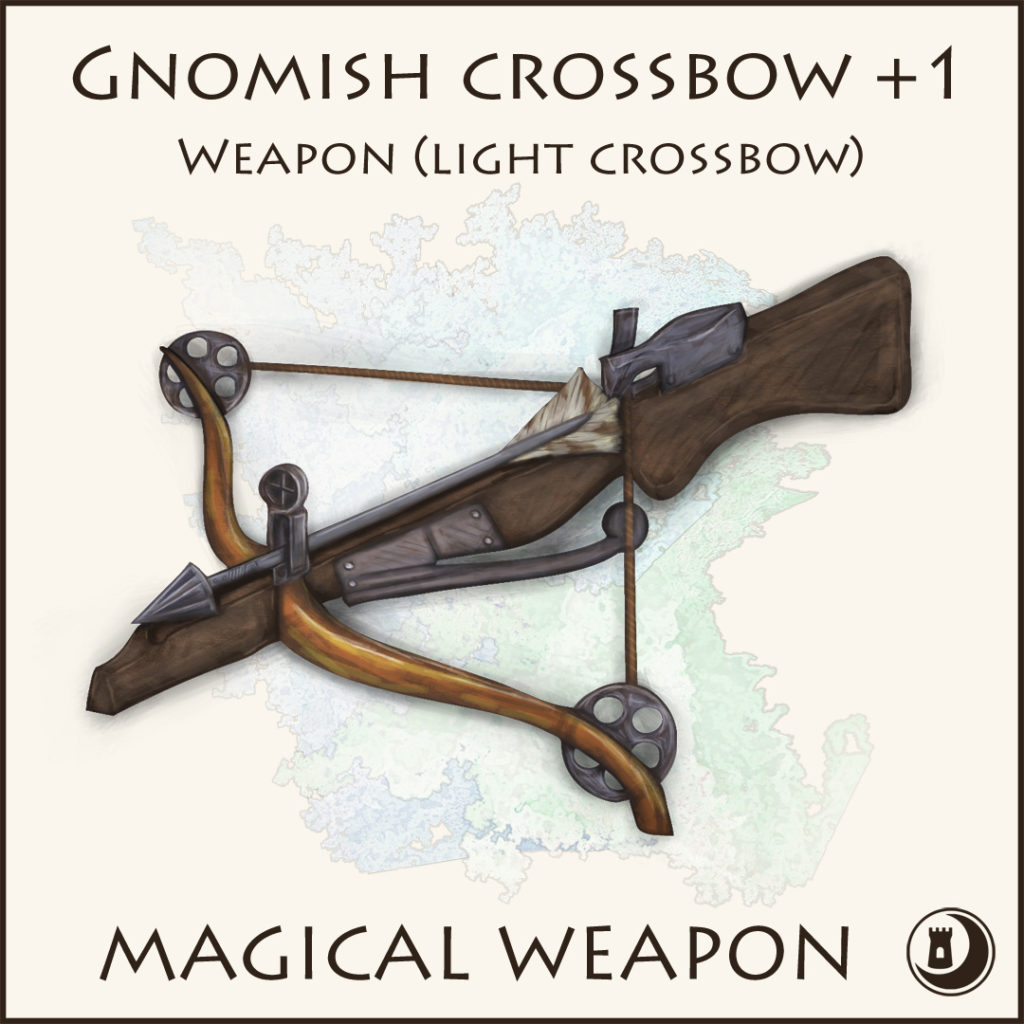
Gnomish Crossbow
Weapon (light crossbow), rare
You have a +1 bonus to attack and damage rolls while using this magical crossbow. If the user spends one or more rounds aiming before firing the crossbow, the attack roll bonus increases to +2. If the user spends one or more rounds aiming while lying prone on their belly, the attack roll bonus increases to + 3.
Because of the crossbow’s powerful limbs, the range of the weapon is 120/480, but it requires specially reinforced ammunition that costs 5 gp per 20 bolts.
This crossbow is both enchanted as well as an example of excellent craftsmanship. It is surprisingly light, weighing merely 3 pounds. Its limbs are made of strong yet flexible alchemically treated bronze, and its mechanism is perfectly tuned.
These crossbows were constructed by Odilla ‘Shamrock’ Grennock after a series of werewolf attacks nearby Wolfberg Pass. Odilla is the Senior Master Tinker and guild leader in Winterhold. She is renown among gnomes all over Eastern Farraway for her legendary mechanical skills and alchemy experiments.
Should the crossbow be damaged, checks made to repair it are made on disadvantage unless they are attempted by a rock gnome proficient with artisan’s tools (tinker’s tools).

Assassin’s Darts
Weapon (dart), uncommon
These darts provide a +1 on attack and damage rolls. In addition, if you take the Attack action on your turn, you can use a bonus action to whisper a command word and cast the 2nd-level spell silence as a bonus action. The spell is centred around the dart and lasts for one minute. Once you have used this feature, you can’t use it again until the dart has recharged after 1d4 days. The darts recharge at midnight.
The darts were a gift to Arthignan Tharliam from his mentor, according to an old diary that was found after Arthignan’s mysterious disappearance more than fifteen years ago. The name and identity of the mentor remain unknown, but it is believed to be a high-ranking member at the royal court.
The darts are incredibly well-balanced and made out of dwarven steel and matte-polished silver oak. The leaded weights give the darts a perfect balance, and they have been further enhanced by magic.

Luck Sling
Weapon (sling), rare
This magical ranged weapon provides a +2 bonus to attack and damage rolls.
A character who rolls a natural 1 when trying to hit a target can choose to re-roll the attack. This feature can only be used once per day and recharges at midnight. When this feature is used, the sling magically glows purple and a scattering of stars appears in the air for a moment together with beautiful music before it fades away again.
If the sling is ever destroyed, a fey creature is summoned. The DM decides which type of creature is summoned and if it is friendly, neutral, or hostile towards the person who destroyed the sling.
The sling is made out of leather with braided cords. It once belonged to a bard named Shaeline Quickfoot, who accidently wandered through a portal to the fey world one drunken midsummer night. Once sober, she was unable to go back, but was found by a spirit who took her to Queen Titania. Shaeline stayed many years in the fey world before she finally returned to the material plane again. Queen Titania herself gave Shaeline this sling before she left.
Shaeline lived a long merry life as a travelling minstrel and wrote several songs about her adventures on the Plane of Fey. Many of her tales and songs are still famous throughout Eastern Farraway and are often played during summer fairs, weddings, and parties.

Finnigan’s Cradle
Weapon (shortbow), rare
This shortbow provides a +1 bonus on attack and damage rolls. In addition, it deals an extra 1d6 piercing damage per hit if the target is any type of giant. The decorative jewels on the bow glow faintly orange if the wielder is within 60 feet of any type of giant. Because of the bow’s strong limbs, a creature must have a Strength score of 13 or higher to be able to draw the bow.
The shortbow is made out of a carved rib bone from the hill giant Finnigan, who was a renowned hoarder of magical treasure. He was bested by the dwarves of the Cragg Clan from the town of Hammersong over a century ago.
The dwarves brought back the bones of the giant along with his treasure and brought these to the artificer Gudrun. She fashioned a shortbow from the giant’s rib, adorned it with magical items from his hoard, and imbued the bow with magical powers. Finnigan’s cradle has been in the Cragg Clan’s family ever since.

Duelist’s Blade
Weapon (dagger), rare
This magical weapon provides a +2 bonus to attack and damage rolls.
In addition, on a roll of a natural 20, you have the chance to disarm or break your opponent’s weapon if they are using a weapon with light or finesse properties. Make a Strength (Athletics) check contested by your target’s Strength (Athletics) or Dexterity (Acrobatics) check, whichever is the highest. If you are successful, you break your opponent’s weapon. Alternatively, if your opponent chooses to, they can let go of their weapon, and your opponent is effectively disarmed.
The Duelist’s blade is an elegant parry dagger, often used by expert duellists and nobles at royal courts. Its handle is decorated with braided silver and a large gemstone and gems (sapphires, emeralds, or rubies), while the blade and cross-guard are made from an alloy of adamantine and hardened steel. Only members of the Blacksmiths Guild in Hammersong know how to make this type of extraordinary weapon.
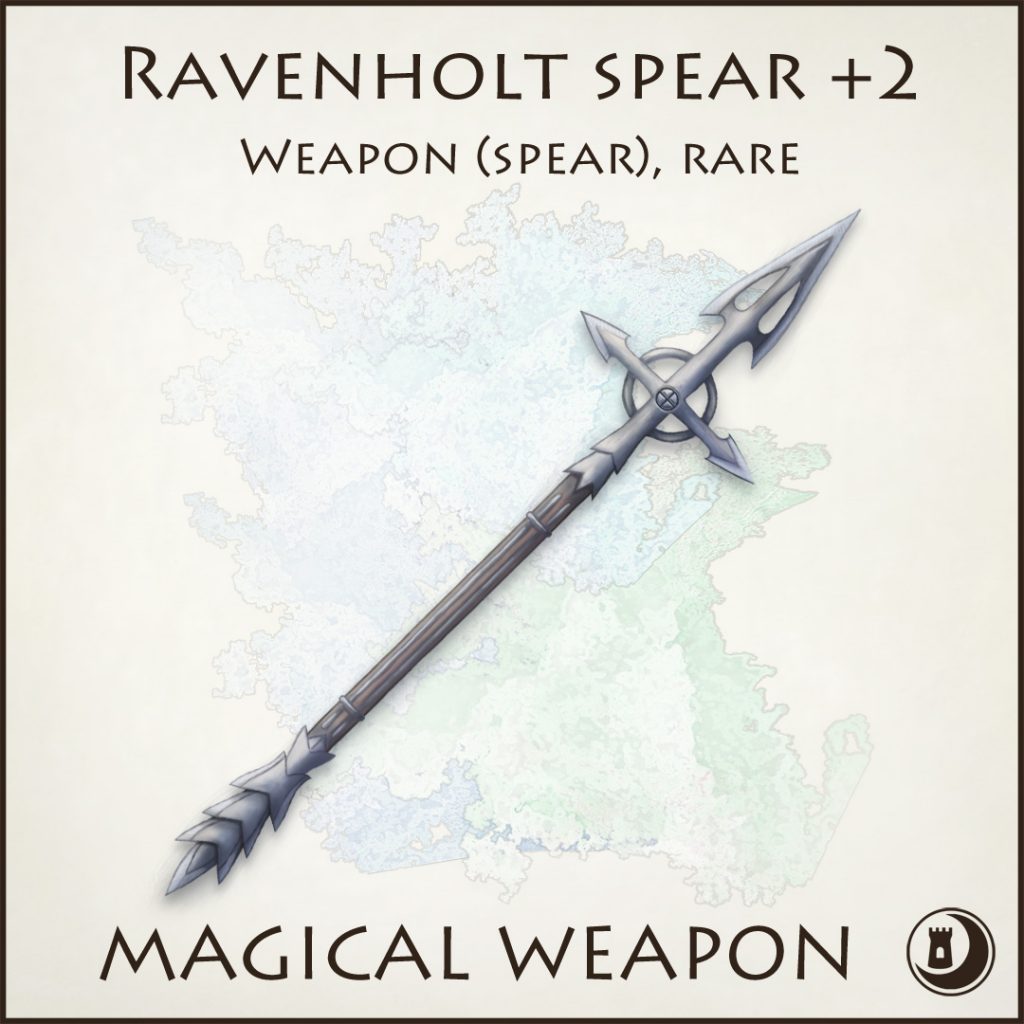
Ravenholt Spear
Weapon (spear), rare
This weapon provides a +2 bonus on attack and damage rolls.
In addition, it does 1d8 extra damage against undead creatures. On a hit, the wielder of this weapon can speak the words ‘Altilia Nexiuous’, which loosely translates to ‘Go back to the darkness’ in ancient Drakkar, as a bonus action, which curses the target as if it were affected by the 1st-level spell hex. Furthermore, when within 120 feet of an undead creature, the blade glows faintly white.
The blade of the spear, as well as its sharp end, is made entirely out of silver. Its wooden handle is made of walnut wood and steel.
This spear once belonged to paladin Arathian Ravenholt, who was renowned for his hatred and lifelong crusade against the undead. Arathian Ravenholt was last seen travelling north, through the Wolfberg Pass. What happened to him, and if he is still alive, is unknown, but travellers found his spear and signs of battle at an old ruin a two-day journey from the Wolfberg Pass.

Moonshard
Weapon (sickle), uncommon
This weapon provides a +1 bonus on attack and damage rolls. It also has the thrown property and a range of 20/60. During night or in dark conditions, it glows pallid blue and provides dim light in a 10-foot radius. The sickle deals double damage against monsters of the plant type and grants the wielder a double proficiency bonus on checks made to craft poison or find herbs.
Moonshard is made of a blue-tinted metal of unknown origin and resembles a (somewhat evil-looking) half-moon. Its wickedly sharp edge never rusts or grows dull, and does not reflect the sun. The handle is inlaid with a sheet of smooth pallid bone branded with a symbol that represents the deity of merciless hunting.
Moonshard has been used by untold evil druids throughout the centuries for harvesting poisonous herbs during night-time as well as for dark rituals. Its origin is lost to scholars, but according to some bards, the Moonshard was forged in the Unseelie court on the Plane of Fey.
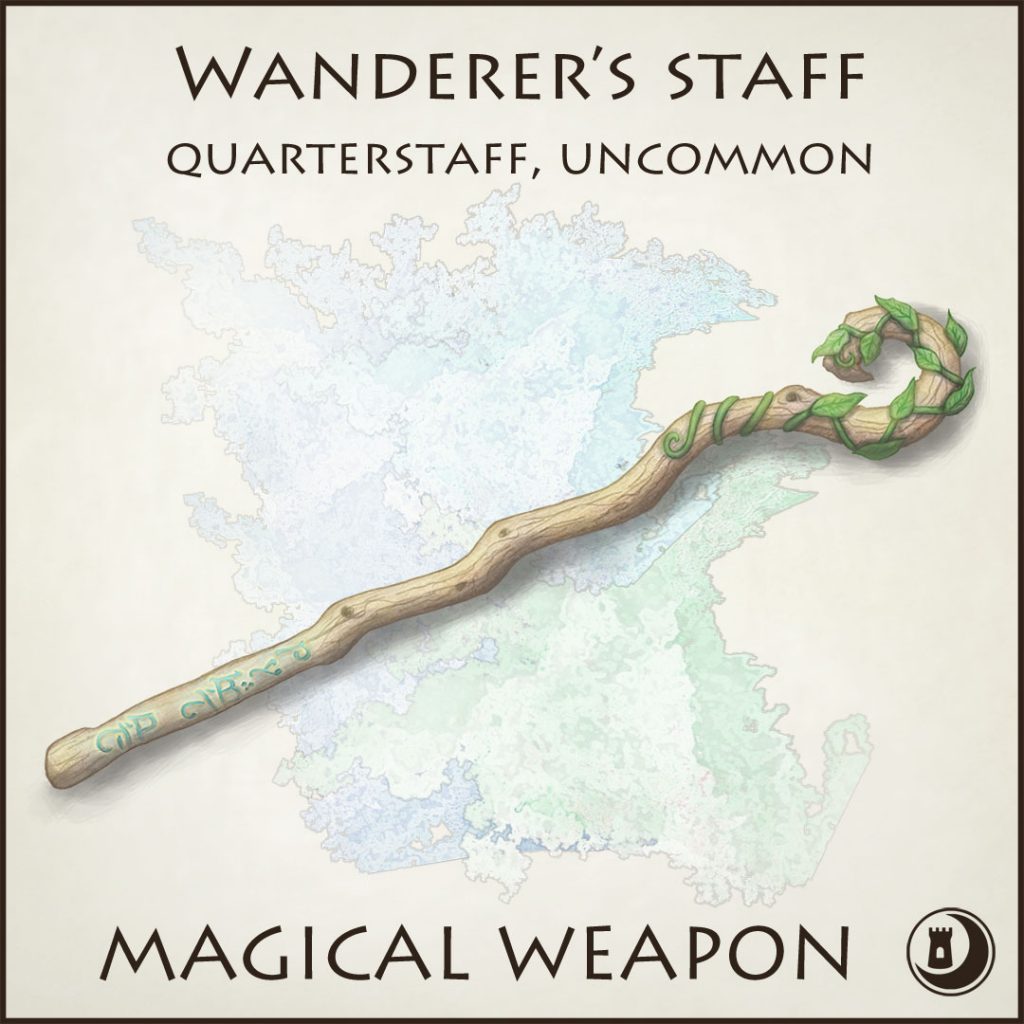
Wanderer’s Staff
Weapon (quarterstaff), uncommon
This elvish quarterstaff provides several benefits to its wielder. A creature that holds the staff is always aware of the direction of north and can move through and travel across difficult terrain at normal speed. The wielder also has advantage on Nature or Survival checks made to predict weather or find shelter. In addition, once per day, the wielder can cast one of the following spells: light, alarm, or goodberry. During the day of the full moon, each of these spells can be cast three times per day.
Wanderer’s Staff is made out of a carved branch of ancient oak, with a comfortable grip that has been sanded smooth and oiled. A string of elvish runes that read ‘Travel well and wander with care’ has been engraved along the length of the staff.
The staff was made centuries ago by artisans and enchanters that belonged to a group of reclusive wood elves. It was presented as a gift to friends of the elves, or to members of their community who planned to embark on especially long journeys.

Hellfire Weapons
Magical weapons (any), uncommon
A living creature that touches a Hellfire Weapon must make a DC 20 Wisdom saving throw. On a success, nothing happens, and the weapon’s magical properties remain dormant. On a fail, the creature’s alignment changes to lawful evil, and the weapon’s magical properties are activated. When activated and wielded, the weapon grants a +1 bonus to attack and damage rolls, and 1d6 additional fire damage on a hit. The wielder also has resistance to radiant damage.
Once per day, you can call forth a hellhound to fight for you. It takes 1 minute to summon the canine fiend. The hellhound attacks on your initiative and obeys your mental commands, requiring no actions on your part. The hellhound returns to its natural plane when it drops to 0 hit points, if your concentration is broken, or 1 hour after you summoned it.
When the weapon is drawn, it burns with a hellish flame, and a faint smell of sulphur lingers in the air. The flames provide bright light in a 30-foot radius.
Hellfire Weapons have been forged in the depths of the Nine Hells, some say by Asmodeus himself.
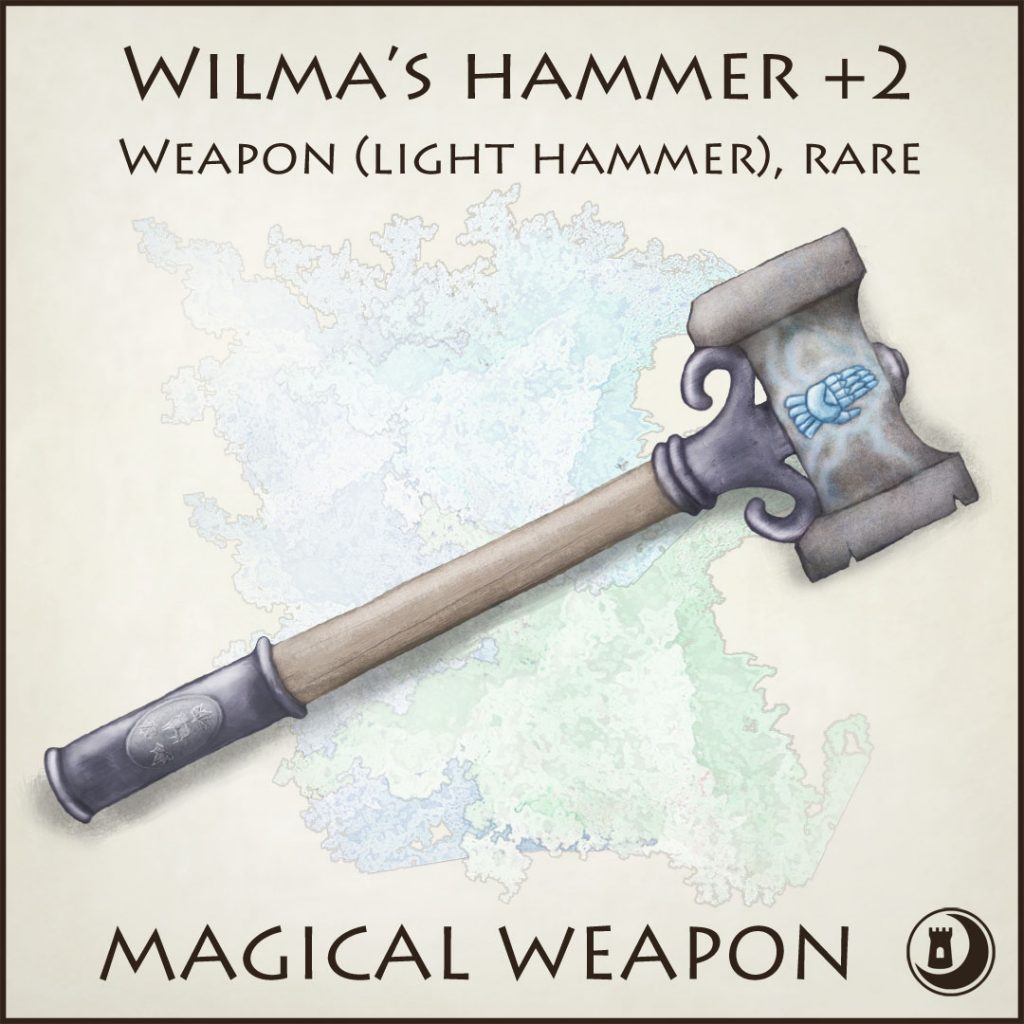
Wilma’s Hammer
Magical weapon (light hammer), rare
This weapon provides a +2 bonus to attack and damage rolls. In addition, the hammer deals an extra 1d4 bludgeoning damage to undead creatures and gives the wielder advantage on saving throws made against being Frightened due to abilities of undead creatures, such as a ghost’s Horrifying Visage ability. The weapon trembles gently and silently when within 30 feet of an undead creature.
This hammer once belonged to Wilma Longstrider, the long-serving captain of the town watch in Littlemoor. The weapon was blessed by a visiting cleric after Wilma rallied the town’s defence to attack a throng of zombies that had risen at a huge nearby cemetery.
The hammer was made by the local blacksmith Jamber Coalrun, who designed it specifically to Wilma’s requirements. Its heavy head is decorated with an embossed symbol of a right-hand gauntlet, and its handle is made from solid white ash and engraved with Littlemoor’s coat of arms: A lamb and three maple leaves.
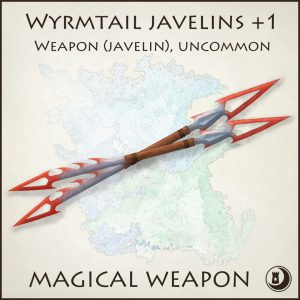
Wyrmtail Javelins
Magical weapon (javelin), uncommon
The weapon provides a +1 bonus on attack and damage rolls. When thrown, the red Wyrmtail javelin catches fire and deals an additional 1d4 damage. Furthermore, the wielder of this weapon can understand and read draconic.
Other Wyrmtail javelins have different effects depending on their colour: green javelins deal 1d4 poison damage, blue javelins deal 1d4 lightning damage, and yellow javelins deal 1d4 radiant damage. Wyrmtail javelins are rare, but are often found in a bundle (roll a 1d6 to decide how many spears the players find).
The javelins are sleek and exceptional light. They are made of one single piece of matte steel and has a long red double-blade. The end of each weapon is shaped like a dragon’s tail. According to legend, Wyrmtail javelins once belonged to fierce dragon hunters in the north, several hundred years ago, but this has never been fully established by scholars at the Seven Keys Library or Winterhold Academy.

Clan-forged Axe
Magical weapon (handaxe), uncommon
This magical weapon is expertly crafted and enhanced by subtle enchantments. It is always warm to the touch, and its innate heat provides a creature that wields it with advantage on Exhaustion checks due to cold conditions. In addition, the handaxe emits a soft, warm yellow glow that provides dim light in a 10-foot radius, even in magical darkness.
The axe is made out of layered adamantine metal and carefully selected hardwood. The smithy’s symbol (an engraved snowflake) can be found at the end of the shaft. It is exceptionally sturdy and has AC 25 and 40 Hit Points if it is targeted by an attack. In addition, it is immune to the Rust Metal ability of rust monsters.
Clan-forged axes are created by following a secret recipe that combines blacksmithing and magic rituals. This recipe is known only to members of the Flinthelm Clan and has been handed down through generations of dwarven blacksmiths at a smithy in the town of Winterhold. Because of its glow, the axe is popular among underground rangers and others who hunt in dark tunnels and caverns.

The Concluder
Weapon (greatclub), uncommon
You gain a +1 bonus to attack and damage rolls made with this magic weapon. On a critical hit, your opponent must succeed on a DC 12 Constitution saving throw or be Stunned until the end of their next turn. In addition, the weapon grants its wielder a double proficiency bonus on Charisma (Intimidation) checks, and it deals triple damage to structures of all kinds.
This massive oaken table leg is covered with countless scratches, notches, cracks, and indents. It also smells strongly of a variety of strong alcoholic beverages. It has no markings or decorations indicating that it is magical, or indeed a weapon.
The Concluder was used for over two decades by the legendary half-orc Tripp Grumch. Tripp worked as a bouncer at the Old Skunk, a tavern in the shadiest district of a large town and notorious for its rowdy guests. One night at closing time, a powerful but dangerously tipsy sorcerer improved Tripp’s club in exchange for an expensive bottle of dwarven rum.
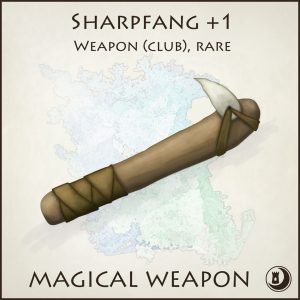
Sharpfang
Magical weapon (club), rare
You gain a +1 bonus to attack and damage rolls made with this magic weapon. Upon a hit, roll 1d10. On a result of 1 to 4, the target suffers an additional 1d4 poison damage. On a result of a 1, the target is also Poisoned for one minute. In addition, when wielded, Sharpfang grants its user a +2 bonus on saving throws against poison.
Sharpfang is an aged and plain wooden club with a fang from a giant spider attached to one end. The fang is dark brown, oily, and gives off an acrid smell that gives the wielder disadvantage on Stealth checks based on smell. Occasionally, a black drop of acrid venom falls from the fang and immediately dissolves when it lands on a solid surface.
Once upon a time, Sharpfang belonged to a mighty goblin boss known as Garelk the Tall. The leader of a vast but unruly goblin tribe, Garelk often resorted to using the club on drunken upstarts who challenged him for leadership or simply tried to start a fight.